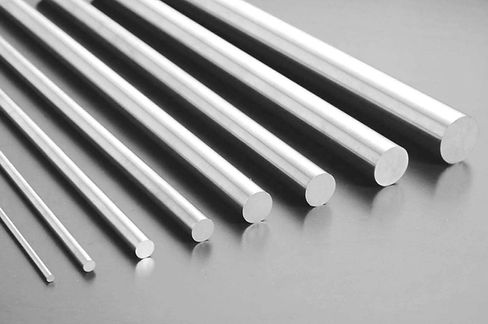Titanium
Titanium is a hard, shiny, strong metal.
Titanium is as strong as steel, but much less dense. Therefore, it is important as an alloying agent with many metals including aluminum, molybdenum and iron. These alloys are primarily used in aircraft, spacecraft and missiles because of their low density and ability to withstand extreme temperatures. It is also used for golf clubs, laptops, bicycles, crutches, etc.

History
Menachanite, the first titanium mineral, was discovered in Cornwall in 1791 by Reverend William Gregor. He analyzed it and deduced that it consisted of oxides of iron and an unknown metal, and reported it to the Royal Cornwall Geological Society.
In 1795, German scientist Martin Heinrich Klaprot investigated a red ore called Schörl from Hungary. It is a form of rutile (TiO2), which Klapros realized that it was an oxide of an unknown element he named titanium. When he heard of Gregor's discovery, he investigated menakanite and confirmed that it also contained titanium.
It wasn't until 1910 that Hunter MA, working for General Electric in the United States, made pure titanium metal by heating titanium tetrachloride and sodium metal.
Appearance
It is a hard, shiny, strong metal.
Uses
Titanium is as strong as steel, but much less dense. It is therefore important as an alloying agent with many metals including aluminum, molybdenum and iron. These alloys are used primarily in aircraft, spacecraft and missiles because of their low density and ability to withstand extreme temperatures. It is also used for golf clubs, laptops, bicycles, and crutches.
Power plant condensers use titanium pipes for their resistance to corrosion; Titanium has excellent resistance to corrosion in seawater, so it is used in desalination plants and to protect the hulls of structures such as ships and submarines exposed to seawater.
Because titanium metal connects well with bone, it has found surgical applications such as joint replacement (especially the hip joint) and dental implants.
The largest use of titanium is in the form of titanium.IV) Oxide It is widely used as a pigment in house paints, artist paints, plastics, enamels, papers, etc. A bright white pigment with excellent coverage. It is also used in solar observatories where the heat causes poor visibility because it is a good reflector of infrared light.
Titanium(IV) oxide is used in sunscreens because it blocks UV rays from reaching the skin. Titanium Nanoparticle (IV) oxide is invisible when applied to the skin.
Biological role
Titanium has no biological role. Non-toxic. Fine titanium dioxide dust is a suspected carcinogen.
natural abundance
Titanium is the ninth most abundant element on Earth. It is almost always present in igneous rocks and the sediments derived from them. It is found in ilmenite, rutile, and spen minerals, as well as titanates and many iron ores.
Titanium is produced commercially by reducing titanium.IV) Chloride with magnesium. Titanium(IV) oxide is produced commercially by the 'sulfate process' or 'hydrochloride process', both of which start from the mineral ilmenite. used as a substance.
